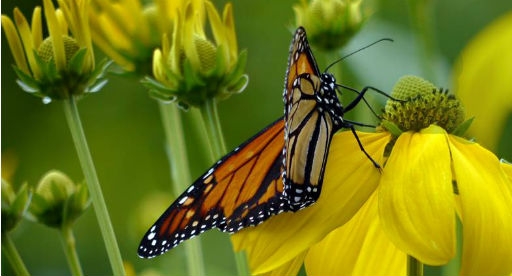
Benefits of attracting butterflies
Your garden will be even more colourful and interesting if butterflies are flying about, nectaring and – as they will do – chasing each other in aerobatic stunts that defy gravity.
Not only that, but some plants are pollinated by butterflies and moths – so your plants will be more fruitful with butterflies about. Butterflies are just as much a part of the garden as any plants and as they are such charismatic they can expand public awareness and interest. While children may not notice other insects in action in the garden they will be captivated by butterflies and you will be able to arouse their interest in what goes on in the garden.
Butterflies are solar-powered
Butterflies arrive in the spring and will stay right through the summer until the last hot days of autumn. Some, such as the Monarch, will overwinter as adults while others will overwinter as caterpillars (larvae) or pupae (the chrysalis or cocoon stage). Some can be seen throughout the year – but they are most obvious on hot days as they need the sun to be able to fly.
What butterflies people are likely to attract
New Zealand has very few species of butterfly, less than twenty, and it’s important that we look after the ones we have. The endemic Red Admiral, for example is only found in this country, and some people say it’s the most beautiful Admiral of them all – and yet in some parts of the country it can no longer be found.
Follow a few simple rules and you could have Red and Yellow Admirals in your garden. Depending on where you live you might also be able to encourage Blues and Coppers, adding a special magic quality to your space.
What and when to plant
All butterflies need two types of plants: the females will lay eggs on host plants and then all adults, males and females need nectar from flowering plants. Butterflies’ eyesight could be described as near-sighted so mass plantings providing lots of one colour guide butterflies to your garden, rather than sporadic spots of colour or mixed colours. Suitable flowers usually have ‘landing platforms’, and many daisies are excellent. On the website of the Moths and Butterflies of NZ Trust (www.nzbutterflies.org.nz) are many suggestions but we suggest that you observe butterflies enjoying flowers in neighbour’s gardens if you’re looking for suggestions.
Every different species of butterfly needs its own species of host plant. For the Monarch butterfly it is milkweed (such as the swan plant) and Admirals will lay eggs on nettles. The Coppers will lay on Muehlenbeckia species. The Southern Blue and Common Blue lay eggs on plants in the Fabaceae family (clover, trefoil, tree lucerne, trefoil) and the Longtailed Blue uses broom and members of the pea family.
'Top tips’/maintenance
Flowering weeds are also great for butterflies for nectar. Over the years people have ‘improved’ plants to make them more attractive for people, but they haven’t necessarily improved their nectar quality. You will often see more butterflies where weeds are growing rather than floating through a well-kept garden where everything is in order!
Butterflies show that a garden is healthy. It is more than a garden, it is biodiversity in action. Some butterflies make great food for birds or other insects. Insects play such a significant role in the world’s ecology due to their vast diversity of form, function and lifestyle and their interaction with plant life.
Why not let a corner of your garden go wild and let our insects do their work!
Article supplied by www.nzbutterflies.org.nz
Photo credits:
Yellow Admiral - Jane Carver
Red Admiral - Norm Twigge
Blue - Jacqui Knight
Monarch - Sally Phillips
Post a comment
Butterfly Guide Comments
Be the first to write a comment